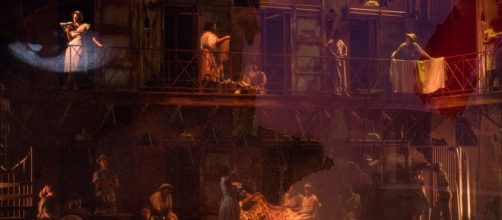Opera at Glimmerglass Festival, in Cooperstown, N.Y., is a North American delicacy. The Festival opened Friday, July 7, with George and Ira Gershwin’s “Porgy and Bess,” performed by a nearly all-African-American cast; the only white performers portray the three white men of the story, who, curiously, are the only ones who never sing a note, but declaim their lines in regular speech. Everything Music and Theatre here reviews the July 13 performance—which registers extremely high on the ‘wow factor’ scale— and explores how some African American performers perceive it and why some say the work is racist, despite the intentions of George and Ira Gershwin.
Composer’s intentions
Lyricist Ira Gershwin, brother to composer George Gershwin, stipulated that only African Americans play the lead roles in United States productions. His intentions were to help launch the careers of black opera singers. Back in 1935, decades before the Civil Rights movement gained full swing, this was groundbreaking policy. Gershwin’s “folk opera” premiered in 1935 and moved directly to Broadway but was not snapped up by the African American population. Fifty years later, in 1985, it finally made it to the stage of New York’s Metropolitan Opera, where, by 1990, it racked up a goodly 54 performances. It has not returned there in the last 27 years.
Mixed feelings
Despite the composer and lyricist’s good intentions, African Americans have only gradually embraced the work, and many still do not extol its virtues.
The trouble lies with the love triangle of Porgy, a beggar, Bess, a powerless woman, and Crown, an abusive stevedore who holds her fast in his clutches. A fourth principal character, Sportin’ Life, is a drug dealer. Clearly African Americans fear that the opera stereotypes the black race as poverty-stricken, addicted to drugs and prone to violence.
The estimable African American soprano Grace Bumbry, who was Metropolitan Opera’s first Bess, told “Humanities” magazine (1997) that she felt “Porgy and Bess” was a step backward in the progress African Americans had made in distancing themselves from such hopeless circumstances.
The present production
Glimmerglass Festival’s title characters are South African bass Musa Ngqungwana and California soprano Talise Trevigne, who pour heart and soul into their performance.
At curtain calls, nearly every audience member had remained seated, just to honor them with a well-deserved standing ovation. With too many high points to mention, their duets are vocal standouts—both “Bess, You Is My Woman,” for its tender sensuousness, and “I Wants to Stay Here, But I Ain’t Worthy,” for its sincere remorse. The artists fully conveyed the characters’ vulnerability without making the audience conscious of their solid vocal technique. Mr. Ngqungwana’s ebony voice abounds with sheer power in the lowest ranges yet rises to a clarion top; Ms. Talise’s is warm, glinting in the heights and displays all the color of a mezzo-soprano at its depths. Their acting is just as phenomenal as their gorgeous singing.
Porgy needs better friends who insist that he gets on that boat! Hope things work out in act 2 @GOpera #glimmerglass pic.twitter.com/lfT6SA7n5S
— Ross Newton (@drrossnewton) 14 July 2017
Supportin’ roles
Sportin’ Life comes to life with the help of tenor Frederick Ballentine. “It Ain’t Necessarily So,” coming through his vocal cords, becomes the funnest sermon ever. The purity of tone in Justin Austin’s vocalism as Jake deserves special mention—who knew “Oh, a woman is a sometime thing” is a “lullaby”? Baritone Norman Garrett, measuring six feet and a gazillion inches, is Crown, a frightening stage presence, with a vocal cannon that rattles the rafters and rebounds repeatedly. His duet with Bess (“What You Want Wid Bess?”) is intense, both for his singing and his creepy acting.
The ladies
From Glimmerglass Opera’s Young Artists Program two sopranos stand out: Meroë Khalia Adeeb as Clara and Simone Z. Paulwell as Serena. Ms. Adeeb sings and reprises the opening “Summertime an’ the Livin’ Is Easy” like the lullaby it’s intended to be, with a warm middle register, a shining, secure top, floated pianissimo and an elegant downward glissando. Ms. Paulwell sings Serena’s “My Man’s Gone Now” as if her life depended on it, and she could heal lepers with “Oh, Doctor Jesus.” Judith Skinner as Maria grabs the audience’s attention, especially in her diatribe against Sportin’ Life, “I hates yo’ struttin’ style.” She, er, well … she kills it.
Fearless leaders
Artistic and General Director Francesca Zambello’s vision for “Porgy and Bess,” with its two-story Catfish Row set, carries gravitas without falling into Depressionland.
Never will you hear a more realistic storm than Act II’s hurricane scene. Maestro John DeMain leads a vivacious orchestral prelude and provides loving support for soloists and chorus, truly chameleonic, taking on the distinct styles—dirges, spirituals, a masterful funeral scene, even an orchestral storm—all spun from the jazz idiom.
Footwork and work afoot
Choreographer Eric Sean Fogel hails from Charleston, S.C., where Catfish Row is set. He provides lively dances in “Oh, I Can’t Sit Down” and other picnic-scene numbers; and his dancers enliven Robbins’ funeral scene (a masterpiece) with organically jubilant steps in “Oh, the Train Is at the Station.” Chorus Master David Moody obtains fabulous results from the 25 or so choral members, who sing as one, in a work that abounds in splendid opportunities for chorus, especially the funeral and storm scenes.
“Porgy and Bess,” by George and Ira Gershwin, till Aug. 21, at Glimmerglass Festival, Alice Busch Opera Theater, Cooperstown, N.Y.


